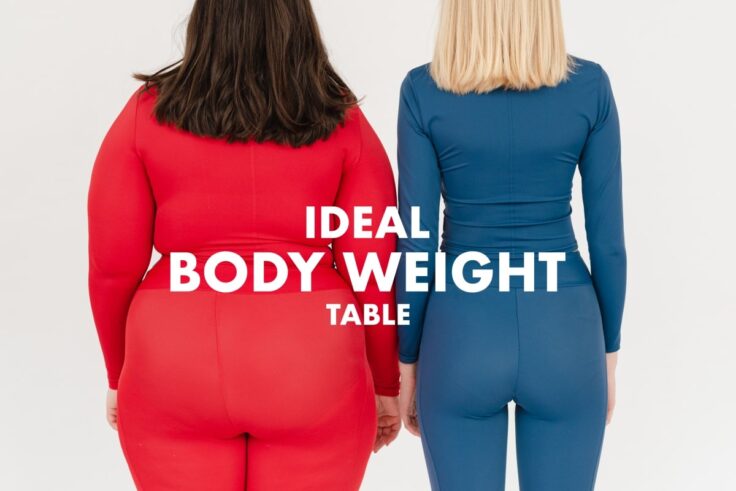Ideal Body Weight Chart – How Much Should I Weigh?

Improve your health and boost your confidence by finding your ideal body weight. It’s not as hard as you might think!
Have you ever wondered, “How much should I weigh?” It’s a common question, but the answer is not one-size-fits-all.
Different factors come into play when determining your ideal body weight, such as your age, height, sex, and even mental health.
While the ideal body weight can vary from person to person, maintaining a moderate weight can lower the risk of developing various health issues such as obesity, type 2 diabetes, high blood pressure, and cardiovascular disease.
However, not everyone with excess weight will necessarily develop health problems.
Still, researchers suggest that difficulties in managing weight could potentially lead to future issues.
So, how can you determine your ideal body weight? Fortunately, various tools and calculators can help guide you in the right direction.
How Is Ideal Body Weight Measured?
There are different methods to measure your ideal body weight:
- BMI – Body mass index measures your ideal weight based on your height;
- WHR – Waist-to-hip ratio indicates the level of belly fat;
- WtHR – Waist-to-height ratio;
- BFP – Body fat percentage is not easy to calculate, since is the ratio between the weight of your body fat and your total weight.
The most popular method to estimate your perfect body weight is the BMI. It’s as easy as taking a look over the below chart and finding where your weight fits, based on your height.
While BMI is not the most precise method for measuring body composition, it can still give you a general idea of your overall health status.
By knowing your BMI, you can get a better sense of whether you’re at risk for health issues related to being overweight or underweight.
Ideal Body Weight Based On Height
The National Institutes of Health (NIH) published a height and weight table to guide you toward the ideal weight for your height:
| Height | Normal BMI 19–24 | Overweight BMI 25–29 | Obesese BMI 30–39 | Extreme Obesity BMI 40+ |
|---|---|---|---|---|
| 4 ft 10 in | 91–115 lbs | 119–138 lbs | 143–186 lbs | 191+ lbs |
| 4 ft 11 in | 94–119 lbs | 124–143 lbs | 148–193 lbs | 198+ lbs |
| 5ft | 97–123 lbs | 128–148 lbs | 153–199 lbs | 204+ lbs |
| 5 ft 1 in | 100–127 lbs | 132–153 lbs | 158–206 lbs | 211+ lbs |
| 5 ft 2 in | 104–131 lbs | 136–158 lbs | 164–213 lbs | 218+ lbs |
| 5 ft 3 in | 107–135 lbs | 141–163 lbs | 169–220 lbs | 225+ lbs |
| 5 ft 4 in | 110–140 lbs | 145–169 lbs | 174–227 lbs | 232+ lbs |
| 5 ft 5 in | 114–144 lbs | 150–174 lbs | 180–234 lbs | 240+ lbs |
| 5 ft 6 in | 118–148 lbs | 155–179 lbs | 186–241 lbs | 247+ lbs |
| 5 ft 7 in | 121–153 lbs | 159–185 lbs | 191–249 lbs | 255+ lbs |
| 5 ft 8 in | 125–158 lbs | 164–190 lbs | 197–256 lbs | 262+ lbs |
| 5 ft 9 in | 128–162 lbs | 169–196 lbs | 203–263 lbs | 270+ lbs |
| 5 ft 10 in | 132–167 lbs | 174–202 lbs | 209–271 lbs | 278+ lbs |
| 5 ft 11 in | 136–172 lbs | 179–208 lbs | 215–279 lbs | 286+ lbs |
| 6 ft | 140–177 lbs | 184–213 lbs | 221–287 lbs | 294+ lbs |
| 6 ft 1 in | 144–182 lbs | 189–219 lbs | 227–295 lbs | 302+ lbs |
| 6 ft 2 in | 148–186 lbs | 194–225 lbs | 233–303 lbs | 311+ lbs |
| 6 ft 3 in | 152–192 lbs | 200–232 lbs | 240–311 lbs | 319+ lbs |
| 6 ft 4 in | 156–197 lbs | 205–238 lbs | 246–320 lbs | 328+ lbs |
The Takeaway
Remember, there’s no one-size-fits-all answer to the question of how much you should weigh. It’s a personal decision that depends on various factors, such as your age, height, and mental well-being.
With the help of BMI and other tools, you can get a good idea of what a healthy weight range might be for you.
Ultimately, the ideal weight for you is the one that makes you feel most comfortable and confident in your own skin.
Use this ideal body weight chart to make informed decisions about your health. And don’t forget, it’s okay to indulge in the occasional treat – life is all about balance, after all.